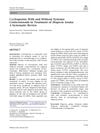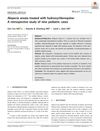 13 citations
,
April 2020 in “Dermatology and therapy”
13 citations
,
April 2020 in “Dermatology and therapy” Cyclosporine combined with corticosteroids is more effective for severe alopecia areata than cyclosporine alone.
 17 citations
,
March 2018 in “Pediatric dermatology”
17 citations
,
March 2018 in “Pediatric dermatology” Hydroxychloroquine may help treat alopecia areata in children.
 14 citations
,
January 2011 in “International Journal of Trichology”
14 citations
,
January 2011 in “International Journal of Trichology” Some people with severe, long-lasting baldness responded well to a specific combination treatment.
1 citations
,
January 2004 30 citations
,
August 1998 in “International Journal of Dermatology” Systemic corticosteroids don't prevent severe alopecia areata from spreading or relapsing.
105 citations
,
December 1995 in “British journal of dermatology/British journal of dermatology, Supplement” PUVA treatment is generally ineffective for alopecia areata.
31 citations
,
January 1981 The document discussed PUVA-therapy as a treatment for alopecia areata, a common cause of hair loss with unknown etiology. It noted that while spontaneous remissions could occur, the prognosis for regrowth was poor in cases of alopecia totalis or alopecia universalis. The study was conducted by I. Weissmann, C. Hofmann, and G. Wagner from the University of Munich, and it was published in 1981. The document did not provide specific details on the study's findings or the number of participants involved.


